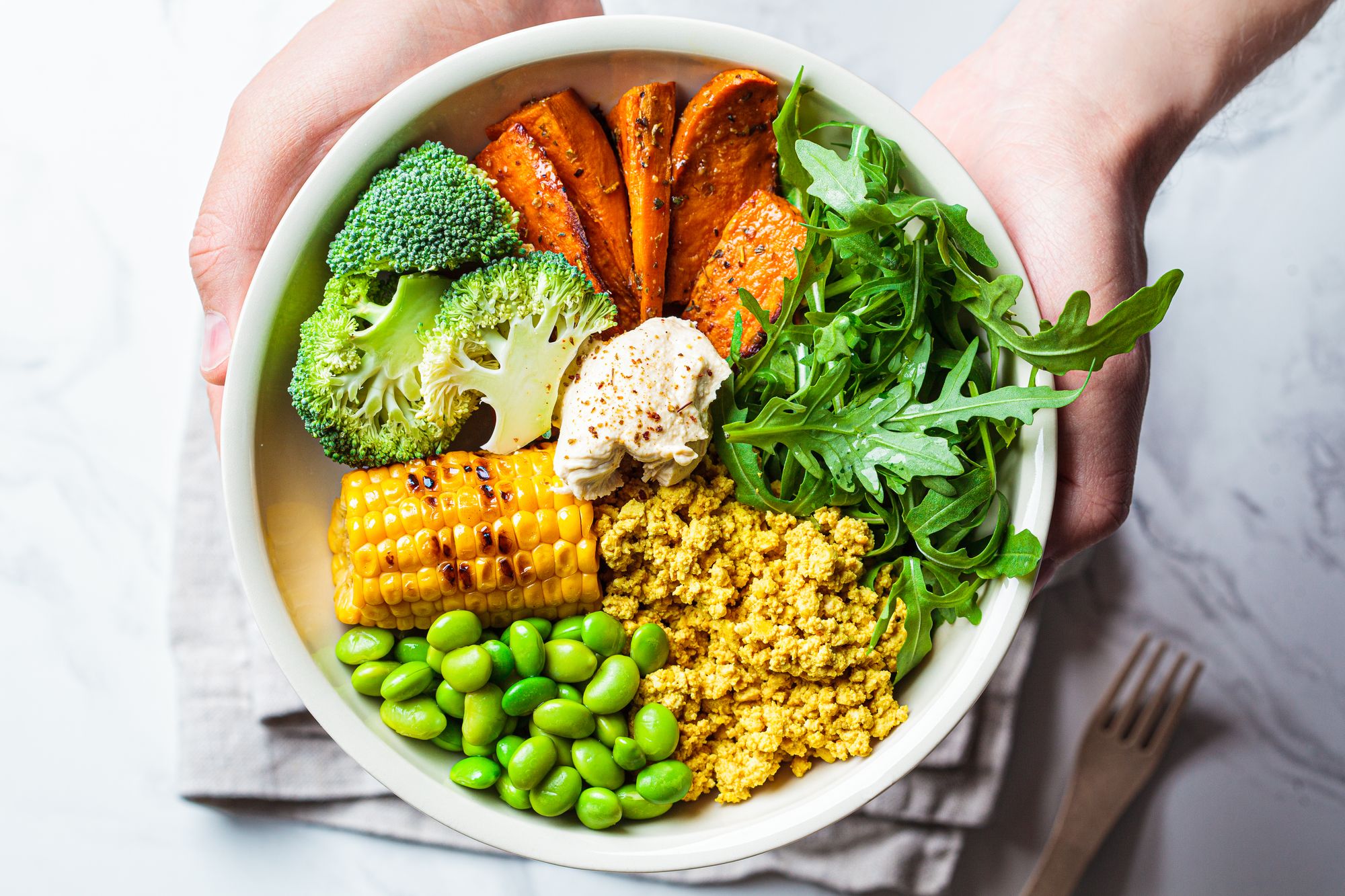Food Sequencing for Weight Loss: Does It Really Work?
"Eat your protein and fat before your carbs to lose weight!" Hmm. Does food sequencing for weight loss (actually) work? We dive into the science.

“STOP front-loading your carbs! It’ll make you overeat and hurt your weight loss goals. Instead, eat your protein and fat first!”
What you just read is nonsense *ahem* has to do with the concept of “food sequencing”, which, well, you’ll spend the rest of this article learning about, so … let’s get started.
What is food sequencing?
Also known as “meal sequencing”, food sequencing refers to the practice of eating protein and/or fat before carbohydrates to positively influence satiety, overall nutrient absorption, and blood sugar levels.
How does food sequencing for weight loss work?
Let’s talk about the weight loss aspect first.
At first pass, using food sequencing for weight loss makes intuitive sense.
(FYI, protein consumption causes a one-two punch, hunger-suppressing effect of decreasing ghrelin* while increasing GLP-1** levels)
However, carbohydrates are still believed to be less satiating because they can cause blood sugar fluctuations; research shows that people whose blood sugar levels dip significantly 2 to 4 hours after eating are more likely to feel hungry sooner.
*Ghrelin is also known as the “hunger hormone”.
**GLP-1 is a hormone that slows stomach emptying and affects satiety-processing brain areas. (Fun fact: GLP-1 is the exact hormone many popular — and highly effective — weight loss drugs, like Ozempic®, mimic.)
But … here comes the big “but” (of course).
Research on using food sequencing for weight loss
Very limited research supports the idea of using food sequencing for weight loss. In truth, we only have a small 2019 study published in the Journal of Diabetes and its Complications.
The researchers cluster-randomized 42 participants with pre-diabetes into 3 groups:
Guess what the researchers found after 6 months?
While those in the food sequence group lost more weight than those in the conventional group, the nutritional balance group participants lost the MOST weight!
Food sequencing benefits for diabetes
Huh, so there’s not much benefit to using food sequencing for weight loss.
But what about for blood glucose levels?
Since protein and fat essentially “slow” digestion, they’ll prolong the time it takes for your body to break down and absorb all those blood-sugar-spiking glucose molecules, right?
In the immediate sense 👍
Well. In the immediate sense, yes.
Several studies show that preloading protein and fat before carbohydrate intake results in lower postprandial (i.e., post-meal) blood glucose spikes for individuals with and without diabetes.
Example: this 2020 RCT published in Clinical Nutrition.
When the participants (16 healthy adults) consumed meat first, followed by rice, they experienced a significantly lower overall postprandial glucose response than when they consumed rice first, followed by meat.
In the long-term sense 👎
Does food sequencing’s benefit on blood glucose levels hold even if we stretch the timeline to months and possibly years?
A 2022 systematic review published in BMJ offers answers.
After analyzing 8 trials investigating the short- (2-hour postprandial glucose levels) and long-term (more than 2 months and less than 2 years) effects of food sequencing on type 2 diabetes, the researchers found little to no difference in:
- HbA1c
- Plasma glucose, insulin, and GLP-1
… levels among those who practiced food sequencing and those who did not.
Takeaway
Given the current scientific literature, it doesn't seem worthwhile to try food sequencing for weight loss and/or blood glucose control.
After all, why subject yourself to such a rigid set of rules when it’s not supported by research? Also, things can get confusing sometimes — e.g., should you treat fries as carbs or fat?
In truth, your big-picture dietary patterns will have a much stronger impact on your weight loss and/or health journey than tying yourself up in knots over the order in which you eat specific foods within a meal.
The principles of achieving weight loss and blood sugar control (for healthy people) are generally aligned:
The only key difference between the goals of weight loss and blood sugar control (once again, this applies to healthy people) is the need for a calorie deficit.
IF you’re trying to lose weight, you should eat fewer calories than your body burns.
But if you’re striving for optimal blood glucose levels, you may or may not need to stick to a calorie deficit, depending on whether you’re already at a healthy weight.
By the way, for those looking for more weight loss support, we have plenty of articles that’ll help, covering topics from how to create and stick to a calorie deficit to whether intermittent dieting strategies could help you:




And if you’re still searching for a strength training program you’ll love, well, you’ll find it right on GymStreak because this smart, AI-powered workout planner tailors your plan to your training status and preferences.
It’ll be the perfect fit.
Here’s a sneak preview:
References
Kohanmoo, Ali, et al. “Effect of Short- and Long-Term Protein Consumption on Appetite and Appetite-Regulating Gastrointestinal Hormones, a Systematic Review and Meta-Analysis of Randomized Controlled Trials.” Physiology & Behavior, vol. 226, Nov. 2020, p. 113123. PubMed, https://doi.org/10.1016/j.physbeh.2020.113123.
Kubota, Sodai, et al. “A Review of Recent Findings on Meal Sequence: An Attractive Dietary Approach to Prevention and Management of Type 2 Diabetes.” Nutrients, vol. 12, no. 9, Aug. 2020, p. 2502. PubMed Central, https://doi.org/10.3390/nu12092502.
---. “A Review of Recent Findings on Meal Sequence: An Attractive Dietary Approach to Prevention and Management of Type 2 Diabetes.” Nutrients, vol. 12, no. 9, Aug. 2020, p. 2502. PubMed Central, https://doi.org/10.3390/nu12092502.
Müller, T. D., et al. “Glucagon-like Peptide 1 (GLP-1).” Molecular Metabolism, vol. 30, Sept. 2019, pp. 72–130. PubMed Central, https://doi.org/10.1016/j.molmet.2019.09.010.
Okami, Yukiko, et al. “Efficacy of a Meal Sequence in Patients with Type 2 Diabetes: A Systematic Review and Meta-Analysis.” BMJ Open Diabetes Research and Care, vol. 10, no. 1, Feb. 2022, p. e002534. drc.bmj.com, https://doi.org/10.1136/bmjdrc-2021-002534.
Rolls, B. J. “The Role of Energy Density in the Overconsumption of Fat.” The Journal of Nutrition, vol. 130, no. 2S Suppl, Feb. 2000, pp. 268S-271S. PubMed, https://doi.org/10.1093/jn/130.2.268S.
Sun, Lijuan, et al. “Postprandial Glucose, Insulin and Incretin Responses Differ by Test Meal Macronutrient Ingestion Sequence (PATTERN Study).” Clinical Nutrition (Edinburgh, Scotland), vol. 39, no. 3, Mar. 2020, pp. 950–57. PubMed, https://doi.org/10.1016/j.clnu.2019.04.001.
Wyatt, Patrick, et al. “Postprandial Glycaemic Dips Predict Appetite and Energy Intake in Healthy Individuals.” Nature Metabolism, vol. 3, no. 4, Apr. 2021, pp. 523–29. www.nature.com, https://doi.org/10.1038/s42255-021-00383-x.
Yabe, Daisuke, et al. “Dietary Instructions Focusing on Meal-Sequence and Nutritional Balance for Prediabetes Subjects: An Exploratory, Cluster-Randomized, Prospective, Open-Label, Clinical Trial.” Journal of Diabetes and Its Complications, vol. 33, no. 12, Dec. 2019, p. 107450. ScienceDirect, https://doi.org/10.1016/j.jdiacomp.2019.107450.
Young, Emily R., and Ishwarlal Jialal. “Biochemistry, Ghrelin.” StatPearls, StatPearls Publishing, 2024. PubMed, http://www.ncbi.nlm.nih.gov/books/NBK547692/.


